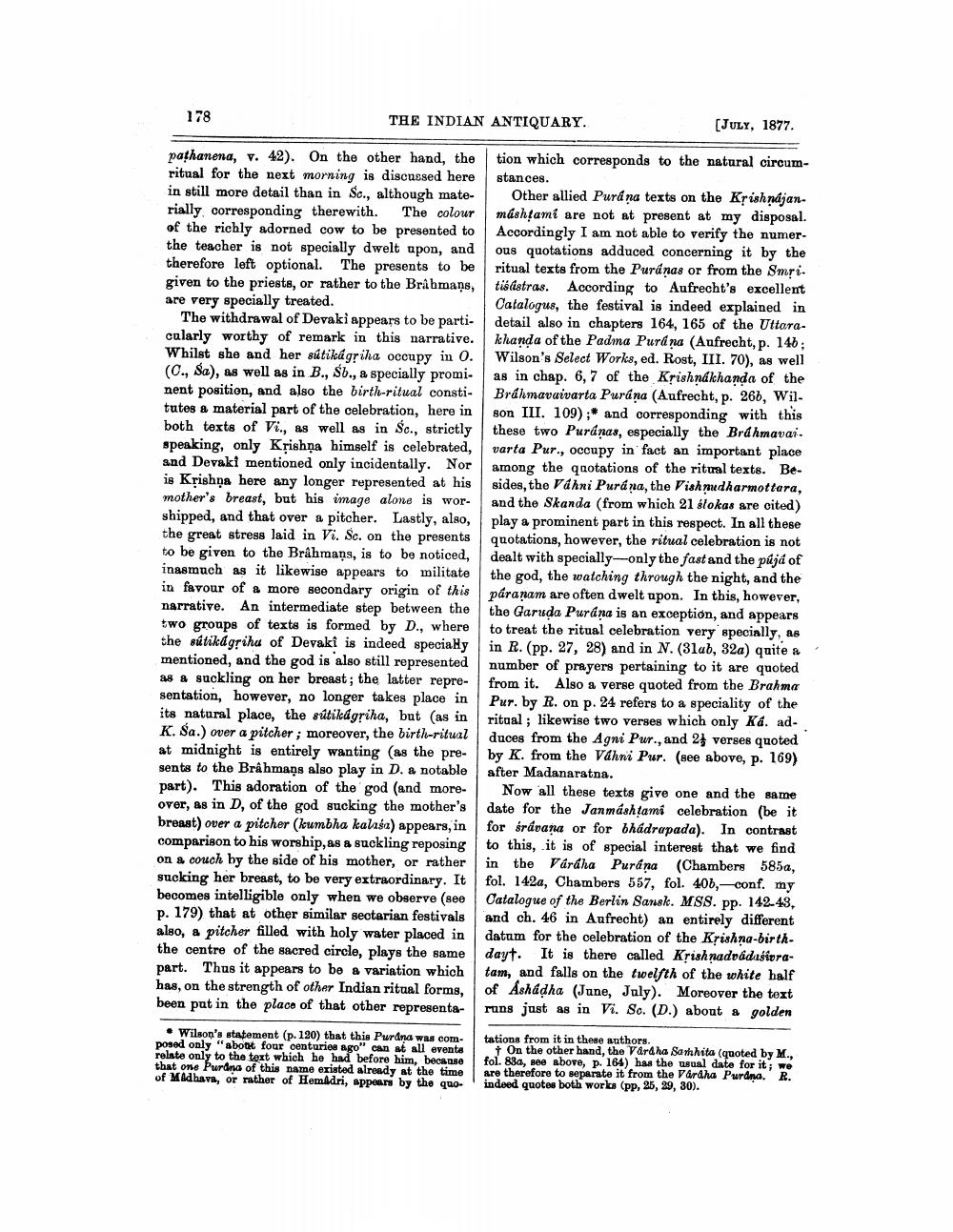________________
178
THE INDIAN ANTIQUARY.
pathanena, v. 42). On the other hand, the ritual for the next morning is discussed here in still more detail than in Sc., although materially corresponding therewith. The colour of the richly adorned cow to be presented to the teacher is not specially dwelt upon, and therefore left optional. The presents to be given to the priests, or rather to the Brahmans, are very specially treated.
The withdrawal of Devaki appears to be particularly worthy of remark in this narrative. Whilst she and her sútikágriha occupy in O. (C., Sa), as well as in B., Sb., a specially prominent position, and also the birth-ritual constitutes a material part of the celebration, here in both texts of Vi., as well as in Sc., strictly speaking, only Krishna himself is celebrated, and Devaki mentioned only incidentally. Nor is Krishna here any longer represented at his mother's breast, but his image alone is worshipped, and that over a pitcher. Lastly, also, the great stress laid in Vi. Sc. on the presents to be given to the Brahmans, is to be noticed, inasmuch as it likewise appears to militate in favour of a more secondary origin of this narrative. An intermediate step between the two groups of texts is formed by D., where the sutikágriha of Devaki is indeed specialy mentioned, and the god is also still represented as a suckling on her breast; the latter representation, however, no longer takes place in its natural place, the sütikágriha, but (as in K. Sa.) over a pitcher; moreover, the birth-ritual at midnight is entirely wanting (as the presents to the Brahmans also play in D. a notable part). This adoration of the god (and moreover, as in D, of the god sucking the mother's breast) over a pitcher (kumbha kalasa) appears, in comparison to his worship, as a suckling reposing on a couch by the side of his mother, or rather sucking her breast, to be very extraordinary. It becomes intelligible only when we observe (see p. 179) that at other similar sectarian festivals also, a pitcher filled with holy water placed in the centre of the sacred circle, plays the same part. Thus it appears to be a variation which has, on the strength of other Indian ritual forms, been put in the place of that other representa
Wilson's statement (p. 120) that this Purdna was composed only "about four centuries ago" can at all events relate only to the text which he had before him, because that one Purana of this name existed already at the time of Madhava, or rather of Hemadri, appears by the quo
[JULY, 1877. tion which corresponds to the natural circum
stances.
Other allied Purana texts on the Krishnajan. mashtami are not at present at my disposal. Accordingly I am not able to verify the numer ous quotations adduced concerning it by the ritual texts from the Puranas or from the Smri tis aistras. According to Aufrecht's excellent Catalogus, the festival is indeed explained in detail also in chapters 164, 165 of the Uttarakhanda of the Padma Purána (Aufrecht, p. 146; Wilson's Select Works, ed. Rost, III. 70), as well as in chap. 6, 7 of the Krishnakhanda of the Brahmavaivarta Purána (Aufrecht, p. 266, Wilson III. 109); and corresponding with this these two Puránas, especially the Brahmavai varta Pur., occupy in fact an important place among the quotations of the ritual texts. Besides, the Váhni Purána, the Vishnudkarmottara, and the Skanda (from which 21 slokas are cited) play a prominent part in this respect. In all these quotations, however, the ritual celebration is not dealt with specially-only the fast and the pújá of the god, the watching through the night, and the páranam are often dwelt upon. In this, however, the Garuda Purána is an exception, and appears to treat the ritual celebration very specially, as in R. (pp. 27, 28) and in N. (31ab, 32a) quite a number of prayers pertaining to it are quoted from it. Also a verse quoted from the Brahma Pur. by R. on p. 24 refers to a speciality of the ritual; likewise two verses which only Ká. adduces from the Agni Pur., and 2 verses quoted by K. from the Váhni Pur. (see above, p. 169) after Madanaratna.
Now all these texts give one and the same date for the Janmashtami celebration (be it for śrávana or for bhadrapada). In contrast to this, it is of special interest that we find in the Váráha Purána (Chambers 585a, fol. 142a, Chambers 557, fol. 40b,-conf. my Catalogue of the Berlin Sansk. MSS. pp. 142-43, and ch. 46 in Aufrecht) an entirely different datum for the celebration of the Krishna-birthdayt. It is there called Krishnadvadasivratam, and falls on the twelfth of the white half of Asháḍha (June, July). Moreover the text runs just as in Vi. Sc. (D.) about a golden
tations from it in these authors.
On the other hand, the Vardha Samhita (quoted by M., fol. 83a, see above, p. 164) has the usual date for it; we are therefore to separate it from the Vardha Purana. R. indeed quotes both works (pp, 25, 29, 30).




